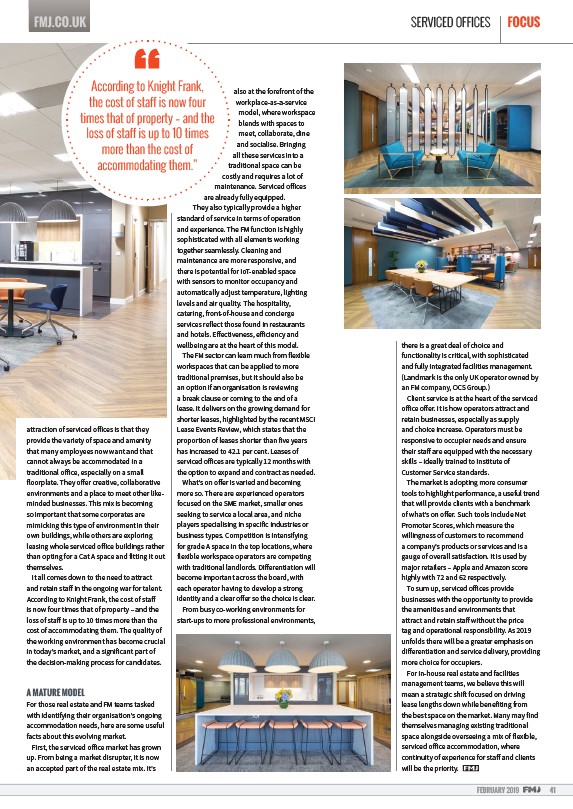
FMJ.CO.UK SERVICED OFFICES FOCUS
FEBRUARY 2019 41
attraction of serviced o€ ices is that they
provide the variety of space and amenity
that many employees now want and that
cannot always be accommodated in a
traditional o€ ice, especially on a small
floorplate. They o€ er creative, collaborative
environments and a place to meet other likeminded
businesses. This mix is becoming
so important that some corporates are
mimicking this type of environment in their
own buildings, while others are exploring
leasing whole serviced o€ ice buildings rather
than opting for a Cat A space and fitting it out
themselves.
It all comes down to the need to attract
and retain sta€ in the ongoing war for talent.
According to Knight Frank, the cost of sta€
is now four times that of property – and the
loss of sta€ is up to 10 times more than the
cost of accommodating them. The quality of
the working environment has become crucial
in today’s market, and a significant part of
the decision-making process for candidates.
A MATURE MODEL
For those real estate and FM teams tasked
with identifying their organisation’s ongoing
accommodation needs, here are some useful
facts about this evolving market.
First, the serviced o€ ice market has grown
up. From being a market disrupter, it is now
an accepted part of the real estate mix. It’s
also at the forefront of the
workplace-as-a-service
model, where workspace
blends with spaces to
meet, collaborate, dine
and socialise. Bringing
all these services into a
traditional space can be
costly and requires a lot of
maintenance. Serviced o€ ices
are already fully equipped.
They also typically provide a higher
standard of service in terms of operation
and experience. The FM function is highly
sophisticated with all elements working
together seamlessly. Cleaning and
maintenance are more responsive, and
there is potential for IoT-enabled space
with sensors to monitor occupancy and
automatically adjust temperature, lighting
levels and air quality. The hospitality,
catering, front-of-house and concierge
services reflect those found in restaurants
and hotels. E€ ectiveness, e€ iciency and
wellbeing are at the heart of this model.
The FM sector can learn much from flexible
workspaces that can be applied to more
traditional premises, but it should also be
an option if an organisation is reviewing
a break clause or coming to the end of a
lease. It delivers on the growing demand for
shorter leases, highlighted by the recent MSCI
Lease Events Review, which states that the
proportion of leases shorter than five years
has increased to 42.1 per cent. Leases of
serviced o€ ices are typically 12 months with
the option to expand and contract as needed.
What’s on o€ er is varied and becoming
more so. There are experienced operators
focused on the SME market, smaller ones
seeking to service a local area, and niche
players specialising in specific industries or
business types. Competition is intensifying
for grade A space in the top locations, where
flexible workspace operators are competing
with traditional landlords. Di€ erentiation will
become important across the board, with
each operator having to develop a strong
identity and a clear o€ er so the choice is clear.
From busy co-working environments for
start-ups to more professional environments,
there is a great deal of choice and
functionality is critical, with sophisticated
and fully integrated facilities management.
(Landmark is the only UK operator owned by
an FM company, OCS Group.)
Client service is at the heart of the serviced
o€ ice o€ er. It is how operators attract and
retain businesses, especially as supply
and choice increase. Operators must be
responsive to occupier needs and ensure
their sta€ are equipped with the necessary
skills – ideally trained to Institute of
Customer Service standards.
The market is adopting more consumer
tools to highlight performance, a useful trend
that will provide clients with a benchmark
of what’s on o€ er. Such tools include Net
Promoter Scores, which measure the
willingness of customers to recommend
a company’s products or services and is a
gauge of overall satisfaction. It is used by
major retailers – Apple and Amazon score
highly with 72 and 62 respectively.
To sum up, serviced o€ ices provide
businesses with the opportunity to provide
the amenities and environments that
attract and retain sta€ without the price
tag and operational responsibility. As 2019
unfolds there will be a greater emphasis on
di€ erentiation and service delivery, providing
more choice for occupiers.
For in-house real estate and facilities
management teams, we believe this will
mean a strategic shi¡ focused on driving
lease lengths down while benefiting from
the best space on the market. Many may find
themselves managing existing traditional
space alongside overseeing a mix of flexible,
serviced o€ ice accommodation, where
continuity of experience for sta€ and clients
will be the priority.
According to Knight Frank,
the cost of staff is now four
times that of property – and the
loss of staff is up to times
more than the cost of
accommodating them.”